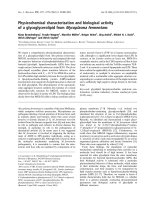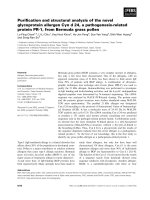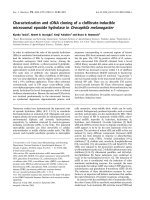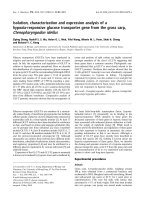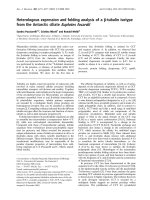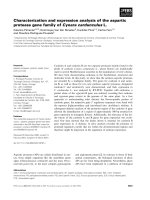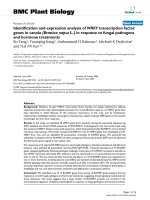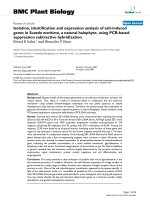Identification, characterization and expression analysis of a novel TPA (12 0 tetradecanoylphorbol 13 acetate) induced gene
Bạn đang xem bản rút gọn của tài liệu. Xem và tải ngay bản đầy đủ của tài liệu tại đây (2.46 MB, 118 trang )
IDENTIFICATION, CHARACTERIZATION AND
EXPRESSION ANALYSIS OF A NOVEL TPA (12-O-
TETRADECANOYLPHORBOL-13-ACETATE) INDUCED
GENE
CHAN CHUNG YIP
(M.B.,B.S. (NUS), M.Med (Surg), MRCS (Edin))
A THESIS SUBMITTED FOR THE DEGREE OF DOCTOR OF MEDICINE
DEPARTMENT OF BIOCHEMISTRY
NATIONAL UNIVERSITY OF SINGAPORE
2006
ACKNOWLEDGMENTS
I would like to thank my thesis supervisor, Dr Caroline Lee, for her constant
support and guidance, and Dr Thomas Adrian at the Northwestern University in Chicago,
who has kindly allowed me to conduct my experiments leading to this thesis in his
laboratory. I especially owe my gratitude to Dr Xianzhong Ding, research assistant
professor at the same laboratory, for his mentorship and faith that he placed in my work.
I would like to thank the National Medical Research Council and Tan Tock Seng
Hospital for sponsoring me in this endeavour. My sincere appreciation to colleagues in
the Department of General Surgery, Tan Tock Seng Hospital, for their friendship and
encouragement.
Lastly, and certainly not in the least, I would like to dedicate this thesis to my
wife, Rachel, and my family, who have made the completion of this possible.
i
TABLE OF CONTENTS
CHAPTER PAGE
1.
INTRODUCTION
1.1 Introduction to Pancreatic Cancer
1.1.1 The Pancreas
1.1.2 Cancer of the Pancreas
1.1.3 Epidemiology of Pancreatic Cancer
1.1.4 Molecular Genetics of Pancreatic Adenocarcinoma
1.2 Analyzing Differential Gene Expression in Cancer
1.2.1 Protein Gel Electrophoresis and Modern Day Proteomics
1.2.2 Differential Hybridization
1.2.3 Subtractive Hybridization
1.2.4 Differential Display
1.2.5 Microarrays
1.2.6 Expressed Sequence Tags (ESTs) and SAGE
1.3 Biology of PKC and TPA
1.3.1 Cell Growth and Tumour Promotion
1.3.2 PKCs and Pancreatic Cancer
1.4 Biology of Transmembrane/ ER Proteins
1.4.1 Orientation and Conformation of the Transmembrane
Protein…………………………………………………………
1.4.2 Protein Glycosylation………………………………………….
1.5 Transcriptional Regulation………………………………………………
1.5.1 Organisation of the Promoter…………………………………
1.5.2 RNA Polymerase II Core Promoter Elements……………….
1.5.3 Sp1/KLF Family of Transcriptional Factors …………………
1.6 Future Directions……….…………………………………………………
1
1
1
2
3
4
14
15
16
17
17
18
19
20
21
22
23
24
25
25
25
27
30
32
2. HYPOTHESIS AND AIMS 34
3.
MATERIALS AND METHODS
3.1 Microarray and Identification of Novel Gene
3.1.1 Cell Culture
3.1.2 RNA Extraction
3.1.3 Oligonucleotide Array Gene Expression Analysis………….
3.1.4 Reverse Transcription and Real-Time Quantitative PCR…
3.1.5 Rapid Amplification of cDNA Ends (RACE)…………………
3.1.6 Construction of Plasmid for Promoter Analysis…………….
3.1.7 Transient Transfection………………………………………
3.1.8 Reporter Gene Assay…………………………………………
3.2 Expression, Structural and Functional Characterization
3.2.1 Cell Culture and Transfection Protocol
3.2.2 Real-Time RT-PCR Analysis of mRNA Expression in
Human Tissues and Cancer Cells
3.2.3 Plasmids Construction
3.2.4 Western Blotting
3.2.5 Deglycosylation Assay
3.2.6 Immunofluorescence
3.2.7 Cell Proliferation Assay by Cell Counting……………………
35
35
35
36
36
38
39
39
40
40
40
40
41
42
43
43
44
44
ii
TABLE OF CONTENTS (continued)
CHAPTER PAGE
3.2.8 siRNA Gene Silencing Assay…………………………………
3.2.9 Cell Proliferation in Collagen I Gel……………………………
3.2.10 Flow Cytometry………………………………………………….
3.3 Transcriptional Regulation
3.3.1 Cell Culture and Transient Transfection
3.3.2 Construction of Plasmids for Promoter Analysis
3.3.3 Site-Directed Mutagenesis for Mutation of Transcription
Factor Binding Sites
3.3.4 Reporter Gene Assay
3.3.5 Electrophoretic Mobility Shift Assay (EMSA)
3.4 Miscellaneous
3.4.1 Sequencing………………………………………………………
3.4.2 Statistical Analysis………………………………………………
45
45
46
46
46
47
48
49
49
50
50
50
4. RESULTS
4.1 Identification and Sequencing of a Novel Gene, TTMP
4.1.1 TPA Induction of TTMP
4.1.2 Full Length Transcript(s) of TTMP
4.1.3 In-Silico Analysis of TTMP……………………………………
4.1.4 Conservation of Orthologous Gene Sequence in Mouse
and Chicken……………………………………………………
4.1.5 Mechanism of TTMP mRNA Induction by TPA……………
4.1.6 Conclusion……………………………………………………….
4.2 Expression, Structural and Functional Characterization of TTMP.
4.2.1 Expression of TTMP in Normal Pancreas and Cancer Cell
Lines
4.2.2 Identification of Translation Start Site and Molecular Size of
TTMP
4.2.3 TTMP is N-Glycosylated and also Contains Sialic Acid
4.2.4 TTMP Localizes to the Endoplasmic Reticulum
4.2.5 TTMP Inhibits Proliferation of Pancreatic Cancer Cells
4.2.6 CT-TTMP, an In-Frame N-Terminal Truncation of TTMP
Enhances Pancreatic Cancer Cell Growth
4.2.7 Forced Expression of TTMP Induces G1 Phase Growth
Arrest in CD18 Pancreatic Cancer Cells……………………
4.2.8 Forced Expression of TTMP Inhibits HeLa Cell Proliferation
4.2.9 Conclusion……………………………………………………….
4.3 Transcriptional Regulation of TTMP Promoter
4.3.1 Sequence Analysis of the 5’-Flanking Region of TTMP
4.3.2 Functional Characterization of the TTMP Promoter
4.3.3 Site-Directed Mutagenic Analysis of the Putative
Transcription Factor Binding Sties Responsible for Basal
Promoter Activity of TTMP
4.3.4 Electrophoretic Mobility Shift Analyses of Physical Binding
of Transcription Factor Sp1 to Putative Cis-Elements on
TTMP Promoter
4.3.5 Conclusion
51
51
52
55
60
61
63
64
65
65
67
70
73
74
78
80
80
82
82
82
83
86
88
90
iii
TABLE OF CONTENTS (continued)
CHAPTER PAGE
5. DISCUSSION AND CONCLUSIONS 92
REFERENCES
98
iv
SUMMARY
Pancreatic cancer is a deadly disease with very poor prognosis. The phorbol
ester TPA has been found to have opposite effects on pancreatic cancer cell growth and
proliferation. Hence we hypothesized that previously undescribed phorbol ester
regulated genes are involved in the growth-dynamics of pancreatic cancer. Using
oligonucleotide microarray, we generated a list of genes that are differentially expressed
following treatment in pancreatic cancer cells with the phorbol ester TPA. We focused
our attention on hypothetical genes that hitherto have not been functionally
characterized, in the hope of finding novel proteins that might be useful as a diagnostic
or prognostic marker, or as a target for intervention. Using transient transfection as a
screening tool, we observed differential growth dynamics of cells transfected with one of
these hypothetical genes, and subsequently focused on the structural and functional
characterization of this gene, which we have named TPA-induced Trans Membrane
Protein (TTMP).
Realtime-PCR analysis using the same samples sets was performed to confirm
up-regulation of TTMP with TPA stimulation seen on microarray. Induction of the gene
was also noted on realtime-PCR to be fairly rapid following TPA treatment and was
concentration dependent. Full length transcript of the gene was cloned and the
sequence has been deposited in NCBI Genebank (AY830714). Using computational
analysis, the amino acid sequence conformed to a single-pass transmembrane topology,
and comparison to its orthologues in mouse and chicken was made. We then
investigated the mechanism of induction of this gene following exposure to TPA.
Pretreatment with actinomycin D did not change degradation kinetics of the message
upon induction with TPA. Using a reporter gene luciferase assay, the mode of induction
was seen to be at the promoter level.
v
TTMP is widely expressed and has a high level of expression in normal pancreas
but is minimally expressed in the cancer cell lines HeLa and CD18. Deglycosylation
assays showed that the protein undergoes post-translational modification by N-
glycosylation and addition of sialic acid moieties. Confocal immunofluorescence
microscopy demonstrated that TTMP is localized to the endoplasmic reticulum and that
this localization process is dependent on the transmembrane domain. TTMP inhibited
CD18 pancreatic cancer cell proliferation. siRNA duplexes knocked-down TTMP
expression and this led to an increase in cell proliferation, as did clones stably
expressing an in-frame N-terminal truncation of TTMP. Cell cycle analysis showed that
forced expression of TTMP induced a G1 phase arrest in CD18 pancreatic cancer cells.
Forced expression of TTMP was also noted to inhibit proliferation in HeLa cervical
cancer cells.
Lastly, basal activity of the promoter region of this gene was characterized. Using
deletion constructs of the promoter cloned into the luciferase reporter vector, the core
promoter region was identified. Further mutational analysis of the core promoter region
showed that 2 putative Sp1 binding sites were responsible for basal activity of the gene.
Physical interaction of Sp1 proteins to these sites was demonstrated using gel-shift
assays.
In conclusion, we have identified and characterized a novel gene that potentially
plays a role in pancreatic tumourigenesis.
vi
LIST OF TABLES
TABLE PAGE
I.
II.
Genes differentially expressed after 8 hours of TPA treatment
Exon-intron structure of TTMP
54
60
vii
LIST OF FIGURES
FIGURE PAGE
1.
2.
3.
4.
5.
6.
7.
8.
9.
10.
11.
12.
13.
14.
15.
16.
17.
18.
19.
20.
Progression model for pancreatic cancer
Core promoter elements
Time course of H
3
-Thymidine incorporation assay in CD18 cells
following treatment with TPA ……………………… ………………………
Differential growth dynamics at 72 hours following transient transfection
with AK026829-ORFpcDNA3.1 …………………………………………….
Concentration response and time course following TPA treatment for
CD18 and HeLa cells
The transcription start sites of TTMP
Nucleotide sequence and deduced amino acid sequence of TTMP
The deduced membrane topology of TTMP
Alignment of the amino acid sequences of human TTMP with mouse
and chicken orthologues
Induction of TTMP mRNA expression in CD18 cells
Expression profile of TTMP in different normal tissues and cancer cells
Genomic organization and open reading frame of TTMP, and TTMP
expression constructs
Molecular size of TTMP
Prediction of N-glycosylation of TTMP
Glycosylation pattern of the TTMP protein
Immunofluorescence localization of TTMP in HeLa cells
Effect of forced expression of TTMP on cell proliferation in CD18
pancreatic cancer cells
Effect of forced expression of TTMP on cell proliferation of CD18 cells in
three-dimensional collagen 1 gels
Effects of forced expression of TTMP and siRNA duplexes targeted to
TTMP on cell proliferation in CD18 pancreatic cancer cells
Effect of forced expression of the C-terminal fragment of TTMP on cell
proliferation in CD18 pancreatic cancer cells
8
26
51
53
55
56
59
61
62
64
66
69
70
72
73
76
77
77
78
79
viii
LIST OF FIGURES (continued)
FIGURE PAGE
21.
22.
23.
24.
25.
26.
Forced expression of TTMP causes G0/G1 phase cell cycle arrest in
CD18 pancreatic cancer cells
Effect of TTMP on HeLa cell proliferation
Sequence of the 5’ flanking region of the hTTMP gene
Deletion analysis of the 5’ flanking region of the hTTMP gene
Mutational analysis of the proximal promoter region of the hTTMP gene
Electrophoretic mobility shift analysis of nuclear protein interactions with
DNA fragments derived from the hTTMP proximal promoter……………
81
81
85
86
87
89
ix
1. BACKGROUND
1.1 INTRODUCTION TO PANCREATIC CANCER
1.1.1
The Pancreas
The human pancreas measures 15-25 cm in length and weighs 70-150 grams. It
is connected to the duodenum by the ampulla of Vater, where the main pancreatic duct
joins with the common bile duct. The pancreas has it embryological origin as two buds
developing on the dorsal and the ventral side of the duodenum. The ventral and dorsal
buds fuse together to form the single organ. The terms head, body and tail are used to
designate regions of the organ from proximal to distal. The pancreas is an organ with
two physiological functions. The acinar and ductal portions of the organ contribute to the
exocrine function whereas the islets of Langerhans provide the endocrine function of the
pancreas. The acinar and ductal cells secrete enzymes and sodium bicarbonate into the
digestive tract respectively. Acinar cells are pyramidal in shape with basal nuclei, regular
arrays of rough endoplasmic reticulum, a prominent Golgi complex and numerous
zymogen granules containing the digestive enzymes. Proteases and phospholipase
originating from the acinar cells are secreted as inactive precursors whereas amylases
and nucleases are secreted as active enzymes. The inactive precursors become active
only in the duodenum. The pancreatic ducts, which secrete a fluid rich in bicarbonate,
are lined with columnar epithelial cells. Secretion of the pancreatic juice is regulated by
hormonal stimulation, principally by secretin and CCK, although neural input is also
involved. The islets of Langerhans are compact spheroidal clusters embedded in the
exocrine tissue. These islets are responsible for secretion of insulin, glucagon,
somatostatin and other peptide hormones. In addition to glandular components, the
pancreas has a rich blood supply. The arterial blood passes through each lobule, first to
the islets and then to the adjacent acini. Various growth factors expressed in the
1
developing pancreas and its surrounding mesenchyme-derived cells are considered to
be involved in the development of the endocrine and exocrine cells (1-5). Members of
the EGF family of growth factors such as EGF, TGFα and betacellulin can bind to EGF
receptors expressed on pancreatic islet cells, acinar cells, and ductal cells and exert
various effects on cell differentiation and proliferation. Other growth factors such IGF-I
and PDGF play a role in pancreatic development (1-5).
1.1.2
Cancer of the Pancreas
The vast majority of cases of pancreatic cancer are adenocarcinomas arising
from the pancreatic ducts (6-8). The typical histomorphology of ductal adenocarcinoma
is one of small neoplastic glands surrounded by an intense desmoplastic stromal
reaction, together with inflammatory cells. Rare tumors arise from pancreatic acinar
tissue or from neuroendocrine cells in the islets of Langerhans. These tumors tend to
have a much different biologic behavior than usual ductal pancreatic adenocarcinoma
and are not discussed further here. Cystic tumors of the pancreas (both mucinous and
serous) also occur and in their pure form have a substantially better prognosis than
ductal carcinomas. These cystic lesions are also excluded from this discussion.
On the scale of public attention, pancreatic cancer ranks far below breast cancer
or prostate cancer. One reason is that it affects far fewer people - tens rather than
hundreds of thousands in the United States, but no other cancer is as aggressive (7-10).
About two-thirds of all pancreatic cancers have already metastasized by the time they
are diagnosed, making curative surgery an option for just 1 in 6 patients. The success of
this procedure, however, is about 1 in 500 (6-10). The five year survival rate is less than
1% and over 90 % of patients die within one year of diagnosis. In spite of considerable
progress in understanding normal pancreatic physiology, the factors that regulate
2
pancreatic cancer cell proliferation and the reasons for the aggressiveness of this cancer
are poorly understood. The only treatment shown to have any effect is surgical resection
(7).Thus the impetus is to understand the molecular mechanisms of pancreatic cancer
and for the search of novel molecular targets for cancer prevention, diagnosis and
treatment.
1.1.3
Epidemiology of Pancreatic Cancer
Though not amongst the top 10 cancers in Singapore, the incidence of pancreatic
cancer has nonetheless steadily risen in the last 35 years. In a 5 year period spanning
1998 to 2002, there is an increase of 9% in males and 16% in females as compared to
the preceding 5 years (11). The aetiology of pancreatic adenocarcinoma remains poorly
defined, although important clues of disease pathogenesis have emerged from
epidemiological and genetic studies. Pancreatic adenocarcinoma is a disease that is
associated with advancing age (12). It is rare before the age of 40, and culminates in a
40 fold increased risk by the age of 80. Environmental factors, in particular smoking,
might modulate pancreatic adenocarcinoma risk (12). On the genetic level, numerous
studies have documented an increased risk in relatives of pancreatic adenocarcinoma
patients (approximately threefold), and it is estimated that 10% of pancreatic cancers are
due to an inherited predisposition (13). As with most cancer types, important insights
have emerged from the study of rare kindreds that show an increased incidence of
pancreatic adenocarcinoma. However, unlike familial cancer syndromes for breast, colon
and melanoma, pancreatic adenocarcinoma that is linked to a familial setting has a lower
penetrance (<10%) and maintains a comparable age of onset to sporadic cases in the
general population. Among the genetic lesions that are linked to familial pancreatic
adenocarcinoma are germline mutations in CDKN2A/p16 (which encodes the tumour
suppressors INK4A and ARF), BRCA2, LKB1 and MLH1 (14). The low penetrance of
3
pancreatic adenocarcinoma that is associated with these germline mutations might point
to a role in the malignant progression of precursor lesions rather than in the limiting
events that control initiation of neoplastic growth from normal pancreatic cells. With
respect to CDKN2A and BRCA2, this notion gains experimental support from the
observation that inactivation of these genes is not detected in premalignant ductal
lesions that are thought to represent early stages of pancreatic tumorigenesis. Beyond
the classical tumour-suppressor mutations, additional genetic defects seem to be
operative in rare families in which pancreatic cancer is inherited as an autosomal-
dominant trait with very high penetrance (13). A pancreatic cancer syndrome that has so
far been identified in a single family has been linked to chromosome 4q32-34 and is
associated with diabetes, pancreatic exocrine insufficiency and pancreatic
adenocarcinoma, with a penetrance approaching 100% (15). Patients with hereditary
pancreatitis, which is associated with germline mutation in the cationic trypsinogen gene
PRSS1, experience a 53-fold increased incidence of pancreatic adenocarcinoma
(16,17). Mutations in PRSS1 cause the encoded enzyme either to be more effectively
autoactivated or to resist inactivation and, consequently, to display deregulated
proteolytic activity. It is assumed that the resulting inflammation promotes tumorigenesis,
in part by producing growth factors, cytokines and reactive oxygen species (ROS),
thereby inducing cell proliferation, disrupted cell differentiation and selecting for
oncogenic mutations.
1.1.4
Molecular Genetics of Pancreatic Adenocarcinoma
Pancreatic carcinogenesis is a multistep process accompanied by accumulation
of many genetic alterations (18). Irreversible genetic changes occur in the initiation and
progression stages of carcinogenesis, while aberrant expression of other genes
accompanies the promotional stage of tumor formation (18). Genetic alterations will be
4
selected in a carcinoma only if these mutations provide the tumor with a selective growth
advantage over its neighboring cells, allows a particular cell to evolve into a separate
clonal population of tumor cells (18,19). This growth advantage is the phenotypic
reflection of changes in the biological pathways in which the protein products of the
mutated genes normally participate (18,20). The activation of K-ras appears to be a
virtual prerequisite for the development of pancreatic carcinoma and alterations in both
K-ras and p16 is an extremely uncommon combination among other human tumor types
(21). Severe chromosomal alterations such as deletions, translocations and gene
amplification are found in pancreatic cancers (22). This has resulted in a large number of
aberrant genes including mutated K-ras and p53 (20-22). A molecular and pathological
analysis of evolving pancreatic adenocarcinoma has revealed a characteristic pattern of
genetic lesions. The challenge now is to understand how these signature genetic lesions
– mutations of KRAS, CDKN2A, TP53, BRCA2 and SMAD4/DPC4 – contribute to the
biological characteristics and evolution of the disease. The progression model for
colorectal cancer has served as a template for relating sequential, defined mutations to
increasingly atypical growth states (23). Whether pancreatic adenocarcinoma behaves in
such a progression series has become an active area of research and certainly answers
will follow in time.
The pancreatic-duct cell is generally believed to be the progenitor of pancreatic
adenocarcinoma. As defined in the landmark study by Cubilla and Fitzgerald (24), the
increased incidence of abnormal ductal structures (now designated pancreatic
intraepithelial neoplasia, PanIN) (25) in patients with pancreatic adenocarcinoma, and
the similar spatial distribution of such lesions to malignant tumours, are consistent with
the hypothesis that such lesions might represent incipient pancreatic adenocarcinoma.
Histologically, PanINs show a spectrum of divergent morphological alterations relative to
5
normal ducts that seem to represent graded stages of increasingly dysplastic growth
(26). Cell proliferation rates increase with advancing PanIN stages, which is consistent
with the idea that these are progressive lesions (25). A growing number of studies have
identified common mutational profiles in simultaneous lesions, providing supportive
evidence of the relationship between PanINs and the pathogenesis of pancreatic
adenocarcinoma. Specifically, common mutation patterns in PanIN and associated
adenocarcinomas have been reported for KRAS and for CDKN2A (27). In addition,
similar patterns of loss of heterozygosity (LOH) at chromosomes 9q, 17p and 18q
(harbouring CDKN2A, TP53 and SMAD4 respectively) have been detected in coincident
lesions. Furthermore, studies have consistently shown an increasing number of gene
alterations in higher-grade PanINs (28-31).
KRAS. The earliest ductal lesions do not usually display genetic alterations.
Activating KRAS mutations are the first genetic changes that are detected in the
progression series, occurring occasionally in histologically normal pancreas and in about
30% of lesions that show the earliest stages of histological disturbance (32). KRAS
mutations increase in frequency with disease progression, and are found in nearly 100%
of pancreatic adenocarcinomas; they seem to be a virtual rite of passage for this
malignancy (33). WAF1 (p21/CIP1) seems to be coordinately induced with the onset of
KRAS mutations, perhaps due to activation of the mitogen-activated protein kinase
(MAPK) pathway (34).
Activating mutations of RAS-family oncogenes produce a remarkable array of
cellular effects, including the induction of proliferation, survival and invasion through the
stimulation of several effector pathways (35). Although the roles of specific KRAS
effector pathways in pancreatic cancer pathogenesis have not been resolved, there is
6
evidence for an important contribution of autocrine epidermal growth-factor (EGF)
signaling (36-40). This autocrine loop and the resulting stimulation of the
phosphatidylinositol 3-kinase (PI3K) pathway is required for transformation of several
cell lineages by RAS-family oncogenes (41). Consistent with the existence of such an
autocrine loop, pancreatic adenocarcinomas overexpress EGF-family ligands (such as
transforming growth factor-α (TGF-α) and EGF) and receptors (EGFR, ERBB2 or
Her2/neu, and ERBB3) (36,38,41). EGFR and ERBB2 induction occurs in low-grade
PanINs, indicating that autocrine EGF-family signaling might be operative at the earliest
stages of pancreatic neoplasia (42). The functional importance of this pathway is
illustrated by the growth inhibition of pancreatic adenocarcinoma cell lines in vitro and in
xenografts following attenuation of EGFR signaling by blocking antibodies or expression
of dominant-negative EGFR alleles (39,40,43).
CDKN2A/p16. Germline mutations in the CDKN2A tumour-suppressor gene are
associated with the familial atypical mole-malignant melanoma syndrome. In addition to
a very high incidence of melanoma, the inheritance of mutant CDKN2A alleles confers a
13 fold increased risk of pancreatic cancer (44). Although pancreatic adenocarcinoma
arises in some but not all kindreds with CDKN2A mutations, there are no clear genotype-
phenotype associations, indicating a modulating role for environmental factors in disease
penetrance (45,46). FAMMM kindreds that harbour mutant loci other than CDKN2A such
as cyclin dependent kinase 4 (CDK4) alleles that abrogate INK4A binding or other
uncharacterized loci, do not have increased incidence of pancreatic adenocarcinoma
(47,48).
Loss of CDKN2A function brought about by mutation, deletion or promoter
hypermethylation also occurs in 80-95% of sporadic pancreatic adenocarcinomas (33).
7
CDKN2A loss is generally seen in moderately advanced lesions that show features of
dysplasia (Fig 1). The dissection of the role of CDKN2A has been a fascinating story as
this tumour-suppressor locus at 9q21 encodes two tumour suppressors – INK4A and
ARF – via distinct first exons and alternative reading frames in shared downstream
exons (49). Given this physical juxtaposition and frequent homozygous deletion of 9p21
(in ~ 40% of tumours), many pancreatic cancers sustain loss of both the INK4A and ARF
transcripts, thereby disrupting both the retinoblastoma (RB) and p53 tumour suppression
pathways. INK4A inhibits CDK4/ CDK6-mediated phosphorylation of RB, thereby
blocking entry into the S (DNA synthesis) phase of the cell cycle. ARF stabilizes p53 by
inhibiting its MDM2-dependent proteolysis. INK4A seems to be the more important
pancreatic cancer suppressor at this locus, as germline and sporadic mutations have
been identified that target INK4A, but spare ARF (33,50,51).
Figure 1. Progression model for pancreatic cancer. The progression from
histologically normal epithelium to low-grade PanIN to high grade PanIN is
associated with the accumulation of specific genetic alterations. (Adapted from
Cancer Res 2000, 60:2002-2006)
TP53. The TP53 tumour suppressor gene is mutated, generally by missense
alterations of the DNA binding domain, in more than 50% of pancreatic
adenocarcinomas (33). TP53 mutations arise in later stage PanINs that have acquired
8
significant features of dysplasia, reflecting the function of TP53 in preventing malignant
progression. In contrast to many other cancer types, there does not seem to be a
reciprocal relationship in the loss of CDKN2A and TP53 (34,52), which points to non-
overlapping functions of ARF and p53 in pancreatic cancer suppression. TP53 loss
probably facilitates the rampant genetic instability that characterizes this malignancy.
These tumours have profound aneuploidy and complex cytogenetic rearrangements, as
well as intratumoural heterogeneity, which is consistent with the ongoing genomic
rearrangements (53,54).
Cytogenetic studies have provided evidence that telomere dynamics might
contribute to this genomic instability. Although reactivation of telomerase is crucial to the
emergence of immortal cancer cells, a preceding and transient period of telomere
shortening and dysfunction might also contribute to carcinogenesis by leading to the
formation of chromosomal rearrangements through breakage-fusion-bridge cycles
(55,56). The survival of cells with critically short telomeres (crisis), which continue to go
through breakage-fusion-bridge events, is enhanced by the inactivation of p53-
dependent DNA damage response (57), allowing the acquisition of oncogenic
chromosomal alterations (58). Studies in the telomerase-knockout mouse support this
model, as telomere dysfunction and p53 loss cooperate to promote the development of
carcinomas in multiple tissues (56). An analysis of a large series of human pancreatic
cancer cell lines revealed that telomeres were frequently lost from chromosome ends
and that anaphase bridging occurred, indicating that persistent genomic instability is
associated with critically short telomeres (58). As these features were observed in both
low and high grade tumours, the authors conclude that telomere dysfunction was an
early step in the pathogenic process. Moreover, studies of pancreatic adenocarcinomas
9
revealed that tumours have shortened telomere length and that the activation of
telomerase is a late event (58-60).
BRCA2. Inherited BRCA2 mutations are typically associated with familial breast
and ovarian cancer syndrome, but also carry a significant risk for the development of
pancreatic cancer. Approximately 17% of pancreatic cancers that occur in a familial
setting harbour mutations in this gene (61). As is the case for those individuals with
germline CDKN2A mutations, the penetrance of pancreatic adenocarcinoma in BRCA2
mutation carriers is relatively low (~7%) and the age of onset is similar to that of patients
with the sporadic form of the disease. Familial breast cancer alleles other than BRCA2
do not seem to predispose to pancreatic adenocarcinoma. Loss of wild-type BRCA2
seems to be a late event in those individuals who inherit germline hetetrozygous
mutations of BRCA2, which is restricted to severely dysplastic PanINs and
adenocarcinomas (61). Although the numbers are small, these patients do not show an
elevated incidence of PanINs. These data are consistent with the possibility that BRCA2
loss promotes the malignant progression of existing lesions in pancreatic neoplasia.
BRCA2 is necessary for the maintenance of genomic stability by regulating the
homologous recombination based DNA repair processes. Consequently, BRCA2
deficiency in normal cells results in the accumulation of lethal chromosomal aberrations
(62). The fact that BRCA2 is selectively mutated late in tumorigenesis probably reflects
the need for DNA damage response pathways to be inactivated first, for example by
TP53 mutation, so that the damage occurred can be tolerated.
Chromosomal instability. Defects in the mitotic spindle apparatus conferred by
centrosome abnormalities might also contribute to the aneuploidy and genomic instability
of pancreatic adenocarcinomas. Centro-some abnormalities are detected in 85% of
10
pancreatic adenocarcinomas, and there is a correlation between levels of such
abnormalities and the degree of chromosomal aberrations (63). Overall, the loss of TP53
and BRCA2, and the detection of abnormal mitosis and severe nuclear abnormalities in
PanIN-3 lesions indicate that genomic instability is initiated at this stage of tumour
progression.
These observations have several implications. First, the detection of clonal
genetic alterations in PanINs and the synchronous adenocarcinomas is consistent with
the concept that PanINs are indeed neoplastic growths that are precursors to
adenocarcinomas. Although KRAS mutations are early, and probably necessary event in
the development of pancreatic adenocarcinoma, their absence in the earliest lesions
indicates that KRAS activation is not responsible for neoplastic initiation. This notion is
supported by the observation of different KRAS mutation between PanINs of the same
individual. One possibility is that the earliest lesions might be non-clonal areas of
aberrant proliferation and altered states of differentiation that are associated with the
replacement of damaged cells and with inflammatory processes. These disruptions in
tissue architecture and induction of cell proliferation could produce a field defect in which
there is significant selection for cells that sustain activating KRAS mutations. Along these
lines, inflammatory stimuli promote the expression of both TGF-α and EGFR in the
pancreatic ducts, providing a pathway that could synergize with activated KRAS (37).
In addition to the extreme aneuploidy of pancreatic adenocarcinomas, there is a
high degree of genetic heterogeneity within these tumours. For instance, different KRAS
mutations and 9q, 17p and 18q LOH patterns have been observed in adjacent PanINs,
and several KRAS mutations have been detected in the same adenocarcinomas (27-29).
Importantly, it seems that there is spatial distribution of genetic heterogeneity (28).
11
Neoplastic foci from adjacent regions tend to show similar mutation patterns, whereas
increasing genetic divergence has been documented in more geographically distant foci.
It seems likely that adenocarcinomas can develop from the clonal progression of one of
several related but divergent lesions. These features might indicate that a key event
beyond the initiation of PanINs is the acquisition of a mutated state that allows initiated
cells to acquire progression associated genetic lesions. It is tempting to speculate that
this tremendous degree of heterogeneity and ongoing instability lies at the heart of the
resistance of pancreatic tumours to chemotherapy and radiotherapy.
The marked chromosomal abnormalities and the disruptions in DNA-repair
processes in pancreatic adenocarcinoma might reflect the existence of additional loci,
the genomic alterations of which contribute to the malignant progression. This is
supported by the detection of recurrent chromosomal amplifications and deletions by
comparative genomic hybridization (CGH) and other cytogenetic methods (54,64). In
addition to the signature losses of 17p, 9p and 18q, deletions of chromosomes 8p, 6q
and 4q, and amplifications of chromosomes 8q, 3q, 20q and 7p have been consistently
reported.
Microsatellite instability. Microsatellite instability is a second mode of genomic
instability that, in contrast to the large scale alterations that are associated with
chromosomal instability, is characterized by very high mutation rates at small DNA
repeat sequences. This phenotype is caused by mutations in DNA mismatch repair
genes, including MLH1, MSH2 and MSH6 and is associated with hereditary non-
polyposis colon cancer (HNPCC) syndrome (65). There seems to be an elevated risk of
pancreatic cancer in HNPCC families (66,67). The pancreatic adenocarcinomas in
HNPCC patients show distinct molecular genetic profiles, such as a lower rate of KRAS
12
and TP53 mutation, frameshift mutations in BAX and TGFβII, characteristic
histopathology and a less-aggressive clinical course compared with pancreatic
adenocarcinomas that occur outside of this syndrome (68-70).
SMAD4/DPC4. Another frequent alteration in pancreatic adenocarcinoma is the
loss of SMAD4/DPC4 (71), which encodes a transcriptional regulator that is a keystone
component in the transforming growth factor-β (TGF-β) family signaling cascade (72).
This gene maps to 18q21, a region that sustains deletion in approximately 30% of
pancreatic cancers (71). The pathogenic role of SMAD4 inactivation is strongly
supported by the identification of inactivating intragenic lesions of SMAD4 in a subset of
tumours. SMAD4 seems to be a progression allele for pancreatic adenocarcinoma, as its
loss occurs only in later stage PanINs (29,30). Moreover, there does not seem to be a
strong predisposition to pancreatic adenocarcinoma in patients that inherit a germline
SMAD4 mutation (that is, in juvenile polyposis syndrome patients). Loss of SMAD4 is a
predictor of decreased survival in pancreatic adenocarcinoma (31), which is consistent
with a role for it in disease progression. The mechanism by which SMAD4 loss
contributes to tumorigenesis is likely to involve its role in TGF-β mediated growth
inhibition. TGF-β inhibits the growth of most normal epithelial cells by either blocking the
G1-S cell cycle transition or by promoting apoptosis (72). The cellular responses to TGF-
β are partially, but not exclusively, SMAD4-dependent (73) and correspondingly,
pancreatic adenocarcinomas show a degree of TGF-β resistance. The roles of TGFβ
signaling in pancreatic adenocarcinoma pathogenesis are not well defined. Studies have
shown inconsistent effects of this cytokine on cultured cell lines with respect to cell
proliferation rates and dependency on SMAD4 status for TGFβ responsiveness (74-77).
13
These ambiguous results probably stem from the heterogeneity that is associated with
cancer cell lines and the non-physiological conditions that are encountered in vitro.
LKB1/STK11. The Peutz-Jeghers syndrome (PJS), which is caused by
LKB1/STK11 mutations is another familial cancer syndrome that is associated with an
increased incidence of pancreatic adenocarcinoma (78). PJS patients are primarily
affected with benign intestinal polyposis at a young age, although advancing age carries
an increased risk of developing gastrointestinal malignancies, including a more than 40
fold increase in pancreatic adenocarcinoma (79).
1.2 ANALYZING DIFFERENTIAL GENE EXPRESSION IN CANCER
Genomics research has transformed molecular biology from a data-poor to a
data-rich science. The draft sequences of the human genome were published in 2001
(80,81), with further refinement addressing the shortcomings of these drafts and leading
towards the goal of a complete human sequence reported just recently published (82).
Current estimates from gene-prediction programs suggest that there are 24,500 or fewer
protein-coding genes. Researchers at the International Human Genome Sequencing
Consortium have confirmed the existence of 19,599 protein-coding genes in the human
genome, and identified another 2,188 DNA segments that are predicted to be protein-
coding genes (Human Genome Project Information,
Of these,
only about a third to half has been functionally characterized. Although classical genetics
has been a powerful tool for dissecting molecular disease that are affected by gain or
loss of function of a protein encoded by a single gene, such a strategy has proved to be
less fruitful for understanding diseases such as cancer that are controlled by many
genes. Adding to the complexity is the fact that many of the so-called oncogenes or
14
tumour suppressor genes are signaling molecules themselves, each of which functions
to control the expression of a subset of downstream genes. So, the analysis of
differential gene expression, known as expression genetics or functional genomics, has
become one of the most widely used strategies for the discovery and understanding of
the molecular circuitry underlying cancer.
Over the past two decades, several methods have been developed to allow
comparative studies of gene expression between normal and cancer cells. Starting with
simple approaches that used gel electrophoresis to compare protein expression,
methods that focused on mRNA analysis have evolved and become increasingly
sophisticated, as a result of the inventions of recombinant DNA, DNA sequencing and
PCR technologies. The principles behind some of the main methods can be grouped as
follows.
1.2.1
Protein Gel Electrophoresis and Modern Day Proteomics
Perhaps the earliest and arguably the most successful example of studying
differential gene expression in cancer was the discovery of the p53 tumour suppressor
protein in the late 1970s. The protein was found to be overexpressed on a one-
dimensional protein gel when normal cells were compared with those that were infected
with simian virus 40 (SV40) DNA tumour virus (83). The later development of two-
dimensional (2D) protein gel electrophoresis, which separates proteins by both size and
charge, allowed a more complete visualization of cellular protein expression (84). The
main shortcoming of these methods is the inability to recover sufficient amounts of the
differentially expressed protein species for further molecular characterization leading to
identification of just 2000 of the estimated 10000 or more different proteins expressed in
a cell. Newer techniques for the analysis of protein expression, collectively known as
15

